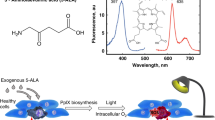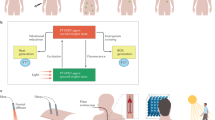Abstract
In this study the localisation of porphyrinoid photosensitizers in tumours was investigated. To determine if tumour selectivity results from a preferential uptake or prolonged retention of photosensitizers, intravital fluorescence microscopy and chemical extraction were used. Amelanotic melanoma (A-Mel-3) were implanted in a skin fold chamber in Syrian Golden hamsters. Distribution of the porphyrin mixture Photofrin and three porphycenes, pure porphyrinoid model compounds, was studied quantitatively by intravital fluorescence microscopy. Extraction of tissue and blood samples was performed to verify and supplement intravital microscopic results. Photofrin accumulated in melanomas reaching a maximum tumour:skin tissue ratio of 1.7:1. Localisation of the different porphycenes was found to be highly tumour selective (3.2:1), anti-tumour selective (0.2:1), and non-selective (1:1) with increasing polarity of the porphycenes. The two non-tumour selective porphycenes had distinctly accelerated serum and tissue kinetics; serum halflife times being as short as 1 min. The specific localisation of the slowly distributed, tumour selective photosensitizers, occurred exclusively during the distribution from serum and uptake into tissues. For the most selective porphycene, the tumour selection process had a halflife of 260 +/- 150 min and led to a strongly fluorescent tumour edge edema. Accumulation of porphyrines by the amelanotic melanoma (A-Mel-3) can be attributed to an enhanced uptake rate for lipophilic molecules in this subcutaneously growing neoplasm. The slow distribution of the two tumour specific photosensitizers and the strong fluorescence of these hydrophobic molecules in the tumour compartment with a high water content indicate a carrier role of serum proteins in the selection process. Enhanced permeability of the tumour vasculature to macromolecules appears to be the most probable reason for the tumour selectivity of these two sensitisers.
This is a preview of subscription content, access via your institution
Access options
Subscribe to this journal
Receive 24 print issues and online access
$259.00 per year
only $10.79 per issue
Buy this article
- Purchase on Springer Link
- Instant access to full article PDF
Prices may be subject to local taxes which are calculated during checkout
Similar content being viewed by others
Author information
Authors and Affiliations
Rights and permissions
About this article
Cite this article
Leunig, M., Richert, C., Gamarra, F. et al. Tumour localisation kinetics of photofrin and three synthetic porphyrinoids in an amelanotic melanoma of the hamster. Br J Cancer 68, 225–234 (1993). https://doi.org/10.1038/bjc.1993.320
Issue Date:
DOI: https://doi.org/10.1038/bjc.1993.320



